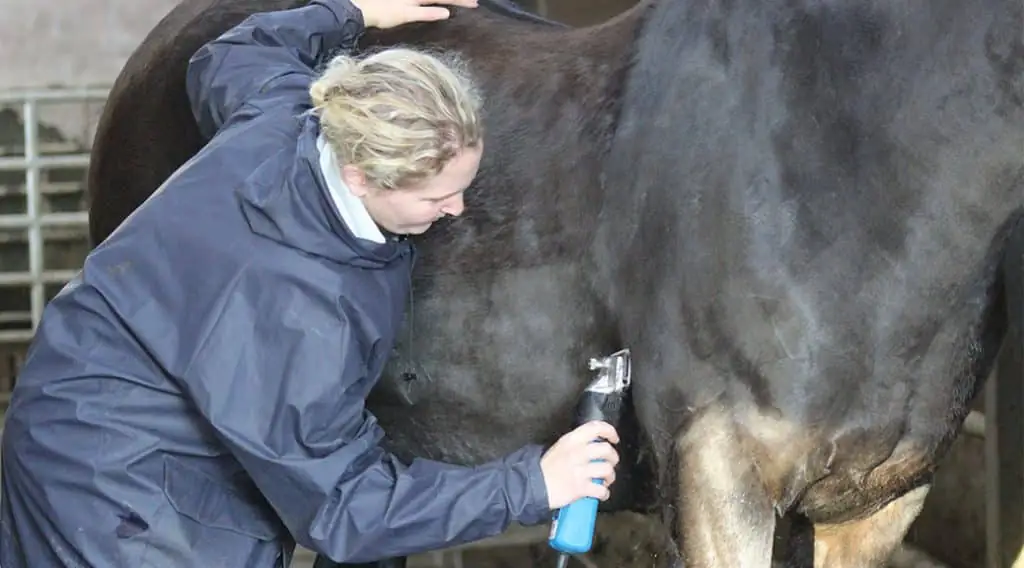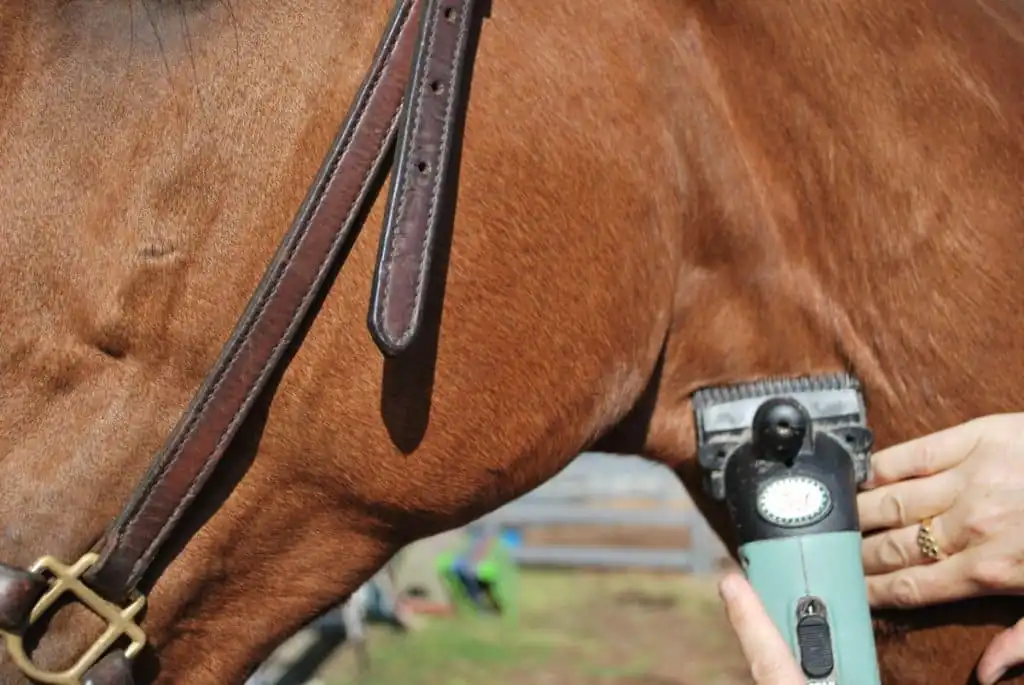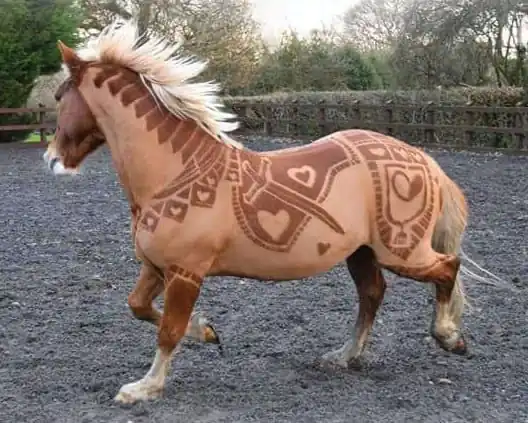Horses have a naturally think coat to help protect them from the elements but while this is a good thing in the wild it can be a bad thing for domestic horses, especially if they’re worked regularly. If your horse gets sweaty during exercise then this can mix with the natural greases in his coat and can cause matting which can also make it difficult for him to regular his temperature. While this is a problem all year round in the summer it doesn’t pose as much of an issue because you can wash the sweat off and then let your horse dry naturally. The biggest problem occurs in the winter when they need the thickness of their coat to keep warm and allowing them to dry naturally will do more harm than good.
Why do I need to clip my horse?
Everybody has their own reasons for clipping their horse and while some reasons are purely from an aesthetic point of view most horses are clipped for health reasons or to help regular their temperature.
Winter clipping
During the winter a horse’s natural coat helps to protect them from the elements and keep them warm throughout the cold and wet winter months. This is great for horses that live outdoors with little or no exercise during this time but for most horses, this thick winter coat can have the opposite effect. When your horse gets sweaty the sweat can mix with the natural greases in his coat which will cause the hair to become matted. This matting can not only become uncomfortable for you horse but over time will start to smell. It’ll also make it harder for him to keep warm because the matted hair will not only take longer to dry but will also clump together and therefore allow the cold air to get in through the gaps, preventing your horse from keeping warm.
Summer clipping
During the warmer summer months it’s much easier to get rid of the sweet by washing your horse down after exercise and then allowing him to dry naturally. That said in some breeds (such as those native to colder conditions as well as some cobs) that have thicker summer coats allowing them to dry naturally can take a very long time, on top of that if they’re worked regularly then their thick coats can put them at risk of overheating.
Clipping for competition or show
Generally, horses and ponies that are used for competition or show are clipped all year round. There are a number of reasons for this but the main reason is that it’s much easier to groom a horse with short hair that isn’t matted.
Clipping to prevent moulting
We all know how much hair your horse can lose when he’s moulting, while different horses will lose different amounts of hair it can be particularly frustrating if your horse deposits all of his unwanted hair over you! To help stop this happening a lot of people will clip their horse just before he starts to moult.
Clipping as a personal preference
As with pretty much everything in life everybody has their own opinion on it and while a lot of people will clip their horse to help regulate his temperature some people just prefer to see a horse with a neatly clipped coat. There’s nothing wrong with this at all but just keep in mind that if you intend to show your horse in breed-specific classes the rules may not permit you to do so.
Clipping a horse with Cushing’s or EMS
If your horse is suffering from conditions such as Cushing’s or Equine Metabolic Syndrome (known as EMS) then clipping him all year round will help him to maintain a normal body temperature. You don’t need to give your horse a full clip, even a chaser or trace clip will allow him to cool enough.
Other reasons for clipping
Vets will sometimes clip horses needing surgery or requiring injections to help keep the area clean and reduce the risk of foreign bodies contaminating the area. Some skin conditions such as lice and ringworm may also mean your horse needs to be clipped.
What type of clip should I go for?
Now that you’ve decided to clip your horse what type of clip should you go for? There are few different types, each one with their own benefits and drawbacks, but before you decide which one to go for you need to take into account how often you exercise your horse, how often he’s stabled and turned out, how much he sweats, does he feel the cold a lot and what rugs do you use. You also need to think about whether your horse has been clipped before or not.
Full
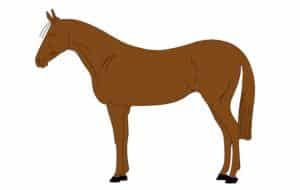
The most extreme clip, as you would expect from its name, the full clip removes all of the horse’s hair, even around their head, ears and legs. This is only suitable for horses in hard completion work and that aren’t turned out at all during the winter months because this clip leaves the horse with no natural protection at all.
Hunter
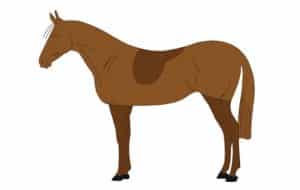
Like the full clip, the hunter clip should only be considered if your horse isn’t turned out during the winter. It’s not as extreme as the full clip so is suitable for horses in medium to hard work. While all hunter clips leaves the saddle area and legs some people choose to leave the head unclipped too while others will trim the hair around the fetlocks too.
Blanket
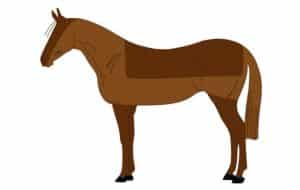
The blanket clip is the most popular type of clip and is suitable for horses in medium work. Unlike both the full and hunter clips, horses with a blanket clip can be turned out during the day when the weather isn’t too cold or wet. As well as the ‘blanket’ area people, as a rule, tend to leave hair in areas where the horse is less likely to sweat such as the head and legs.
Chaser
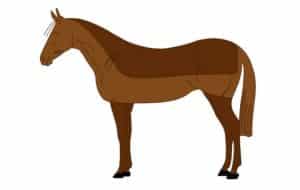
Very similar to the blanket clip, the chaser clip is also suitable for horses that are in medium work. The clip allows for the horse’s neck muscles to be kept warm while the air is able to get to the areas that are more likely to sweat.
Tracer
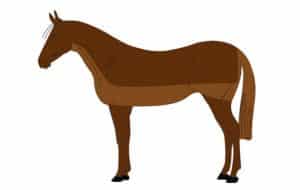
Horses with a tracer clip (sometimes referred to as a trace clip) can be turned out during the day, this is because only a small amount of hair is removed. Some people prefer to leave all of the hair on the horse’s head and neck while others prefer to partially remove it. The clip gives the horse more protection and warmth than both the blanket and chaser clips do as well as obviously the full and hunter clips.
Irish
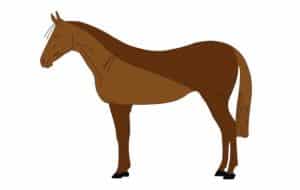
Suitable for horses in light work the Irish clip is fairly easy to do because you’re only removing the hair around the neck and ‘armpits’ of the horse. This clips still allows the horse to keep warm naturally so they can be turned out during the day if necessary or required as long as he has a suitable rug though.
Bib (or strip)
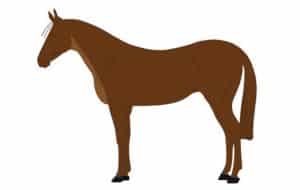
Perfect for horses in light work, the bib clip takes the least amount of hair off. It can also be a good introduction for horses that have never been clipped before because it can help to build their confidence about clipping. Some people continue the clip through the horse’s forelegs to the belly where the girth goes, this has led to the bib clip also being known as the neck and belly clip. As long as your horse is suitably rugged and has access to a shelter he can be turned out all winter (both day and night) with a bib clip.
How do I clip my horse?
You’ve decided you’re going to clip your horse and even decided on the most suitable type of clip, the next step now is to actually clip him, so how do you do that?
Take your time when clipping your horse, there’s nothing worse than running out of time and leaving your horse only half done or with wonky lines because you rushed it. Always groom your horse first, this will not only help to get rid of any loose hairs but also remove any dirt in his coat. Some people insist on washing your horse first but this is up to you. I find marking the area out with chalk beforehand very helpful, this allows me the check everything is even before I start. It also helps me to know exactly what to cut so I don’t have to keep stopping and checking that I’m doing it correctly and evenly. I also like to bandage the tail before I start, that way there’s no chance of the tail getting tangled up with the clippers. If you don’t want to do this you can always ask somebody to hold the tail out of the way when you get to that area.
Let your horse know what you’re doing before you start, allow him to see and sniff the clippers. If your horse is nervous or gets frighted easier it’s a good idea to switch the clippers on a few feet in front of his nose so he can see what’s making the noise. Allow him to get used to this and then place them, without the blades, on his shoulder so he can become accustomed to the vibrating sensation. Once he’s happy with this you can then begin clipping him.
When you start to clip your horse hold the clippers firmly and apply gentle but even pressure to your horse. Starting in the least sensitive areas (such as his neck or shoulders) move in the opposite direction of the hair growth. If you use long strokes that overlap each other you’ll get the smoothest cut. If you can, use a smaller set of clippers for delicate areas such as the face.
Once you’re done make sure you put a rug on your horse even if you’re going to stable him straight after. This is because he won’t be used to having less hair straightaway so using a rug will help him to adapt slowly to it. As a rule of thumb, the thickness of the rug should be determined by the coat you’re wearing, for example, if you’ve got a think winter coat on put the same on your horse, if however you’re not wearing a coat or have a thin summer one put a summer rug on your horse.
How do I avoid tram lines?
Let’s face it nobody likes to see the lines left by the blades of the clippers but luckily getting rid of them is pretty easy to do. Keeping your clippers well oiled will help to reduce the lines but more importantly keep an even pressure when cutting. Also, rather than keeping each cut separate overlapping them will blend the cuts in and help to reduce any tram lines. Once you’ve done that gently hover over the whole area with the blades as if you’re hoovering around delicate furniture. It sounds silly but doing this really does work.
Tips for clipping
Over time as you become more experienced you’ll pick up your own tips and tricks for clipping horses but here are a few things that I’ve learnt myself, hopefully, some of them may be of interest and help to you.
- Use two pairs of clippers – While large clippers can be great at getting the job done quickly they’ll be much more of a hindrance around delicate areas such as your horse’s hair. Using a small set of clippers around these areas will make it easier for you and less unnerving for your horse.
- Let your horse know what you’re doing first – Horse’s are flight animals so if you start the clippers then charge in and begin clipping him immediately he’ll understandably be frightened. It’s always a good idea to let him see the clippers beforehand and even start them up so he knows what the noise is. This is especially important for nervous horses or those that haven’t been clipped before.
- First time clipped horses – If you’re clipping a horse for the first time then it can sometimes help to clip an experienced horse near him first of all. This will not only get him used to the sound but will also reassure him that there’s nothing to be frightened over.
- Start with less sensitive areas – Starting with these areas will help your horse get used to the vibration before you move onto more sensitive areas. Doing this will reduce the chances of him twitching with in turn will help you keep your lines straight.
- Don’t clip over wrinkled skin – Use your free hand to keep your horse’s skin-tight, clipping over wrinkles and folds is likely to not only produce uneven results but could also hurt him.
- Wear cotton overalls – If you’re clipping your horse in the winter it might be tempting to wear a nice warm fleece jumper. Believed me this is a bad idea, the first time I ever clipped a horse I wore just such a fleece and you wouldn’t believe the amount of hair that stuck to it. Even after several washes, I was still finding hair attached to it! Since then I’ve learnt that cotton is best and have invested in a pair of cotton overalls just for clipping.
- Tidying up loose ends – Once you’ve finished clipping your horse you may find that there are a few longer hairs left, especially around the legs and ears. You can either use the smaller clippers to remove these or a sharp pair of scissors. If you’re using scissors try to use a pair with a rounded end.
- Wipe your horse with a damp sponge after – Once you’ve finished go over your horse’s coat with a warm damp sponge, this will help remove any loose hair as well as get rid of any dust left on his coat.
- Always use a circuit breaker – If you’re using clippers that are powered off of the mains then you should use a circuit breaker. It’s also important to switch the power off straight away if your horse stands on the cable.
Clipper maintenance
It’s just as important to keep your clippers maintained properly, not doing so will only cause problems for you and your horse. Clean them thoroughly after every use and make sure you keep them well oiled. You’ll also need to keep the blades sharp and replace blunt ones straight away. Brushing excess hair off when you’re using them will also help to keep them in good condition.
Just for fun
As you become more experience with clipping your horse may want to try your hand at something a little more artistic and fun. A trend has recently begun for people cutting patterns with the clippers in their horse’s coats. These can range from subtle markings to the more extreme ‘external skeleton’ effect and with competitions emerging on social media for the more unusual patterns and designs this is only going to become more popular.
I hope you found this article helpful. If you did I’d be grateful if you could share it please as it would really help me.
Recommended products
Over the years I have tried hundreds of different horsey products, from various blankets and halters to different treats. Some I’ve loved, others I’ve hated but I thought I’d share with you my top all-time favorite products, the ones I never leave the yard without. I’ve included links to the products (which are in no particular order) that I really think are great.
- Horse Knots by Reference Ready – If you’re like me and enjoy pocket reference guides then you’ll love this knot tying guide. These handy cards can easily fit in your pocket or attach to the saddle for quick reference. They’re waterproof, durable and are color coded to make them easy to follow.
- Mane ’n Tail Detangler – Even if you never show your horse you’ll need to detangle his tail from time to time (and possibly his mane too) which is always a challenging chore! I’ve found that if I run a little bit of detangler through my horse’s tails every few days it stops them from getting matted up and makes combing them easy, even if they’re coated in mud. I don’t know if I should admit to this or not but it also works wonders on my hair.
- TAKEKIT Pro clippers – Over the years I’ve tried a lot of different clippers and while some were obviously better than others I found these to be by far the best. They are heavier than a lot of other clippers but for me, that’s a good thing, it makes them feel more sturdy and hardwearing. On top of that they have a range of speeds so are just as good for clipping your horse’s back as they are his face. I also like the fact that they come in a handy carry case but that’s not for everybody. The company that makes them is super good and incredibly helpful too, a real bonus these days. The only thing I wasn’t keen on was the fact that it doesn’t come with any oil, but that’s not a major problem as it’s not difficult to buy lubricant.
- Shire’s ball feeder – There are so many boredom buster toys out there but I like to use these every day, regardless of whether or not my horses are bored. I find that it helps to encourage my horses to problem solve by rewarding them with treats (or pieces of fruit) but it also mimics their natural grazing behavior which helps to keep them calm and de-stressed.
- Horse safe mirror – This is a strange one that many people are surprised about but I like to put horse safe mirrors in the trailers as well as in the quarantine stalls. It helps to prevent the feeling of isolation by giving the impression of other horses being around. Being herd animals horses can get extremely stressed when they feel that they’re on their own but with these stick-on mirrors, they believe that at least one other horse is with them.
- Rectal thermometer – I know this isn’t glamourous at all but it’s vital for your horse’s well-being to be able to check their temperature and a rectal thermometer is the easiest way of doing this which is why I’ve added it to the list.
Shopping lists
I’ve also put together a few shopping lists of essential items that I’ve found helpful over the years. I’ve broken the lists down into different categories rather than put everything in one massive list 😉

